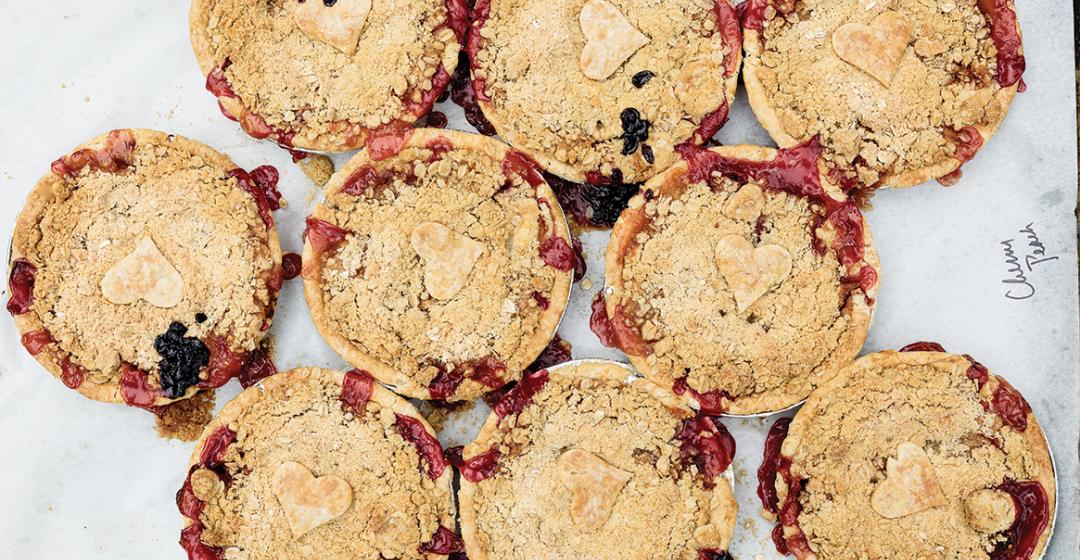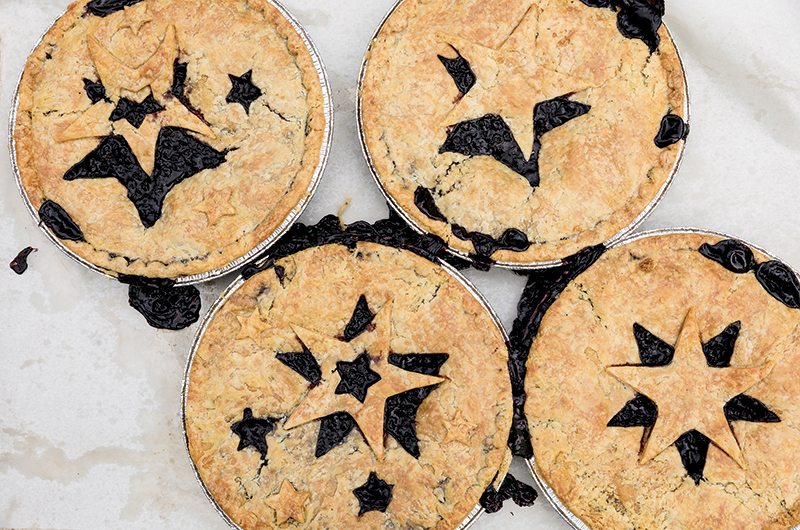Makes two pie crusts for one double-crust pie or two single-crust pies.
Chrissy Kinsman, owner of Pie Chicks Bakery, shared her crust and filling recipe template that can be used interchangeably for fruit pies, depending on your choices and the season. Make it a blueberry pie for July or August or peach, peach/blueberry, peach/raspberry, peach/plum/cherry, apple, and so on. Below, she also guides you through the pitfalls of making a good pie crust. The crust calls for butter plus sustainable palm shortening, which can be found at Whole Foods or online, or by substituting Earth Balance from Cronig’s Market or leaf lard if available. These days, Crisco (shortened from crystallized cottonseed oil) is considered a harmful trans-fatty oil that can lead to inflammation.
Pie Crust:
- 2 cups flour
- 1 1/2 teaspoons sugar
- 1 teaspoon Kosher salt
- 8 tablespoons cold European-style butter (83 percent butterfat)
- 5 tablespoons organic, sustainably sourced palm shortening
- 3 to 6 tablespoons ice-cold water
1. Cut butter into ½-inch pieces and return to refrigerator until ready to use.
2. Whisk flour, sugar, and salt together. Using a food processor or KitchenAid mixer, pulse the cold butter into the flour mixture (6 to 7 pulses) until butter pieces are the size of almonds. (Alternatively, use a pastry blender or your fingers to incorporate butter pieces into the flour.)
3. Pulse shortening into the mixture until just combined. Butter and shortening pieces should be pea sized. (Do not over mix or you will have paste!)
4. Sprinkle 4 tablespoons of ice-cold water onto the fat/flour mixture. Using a rubber spatula, use a folding motion to gently mix and press down on dough so that it starts to hold together. If more water is needed, add it 1 tablespoon at a time, repeating a gentle folding motion and pressing down on dough with spatula until dough just holds together.
5. Separate dough into two even-sized balls and then flatten into two rounded discs.
6. Wrap discs tightly with plastic wrap and refrigerate at least 1 hour and up to 24 hours. (Dough can be made ahead of time and frozen for up to 1 month. To thaw, place in refrigerator overnight.)
Tips:
- Keep butter cold.
- Add ice cubes to the water 10 minutes before starting recipe.
- Don’t over mix the dough! Gentle mixing equals flaky, tender pie crust.
- Relax. Slow down and enjoy this process.
- Roll the dough as thin as possible. Don’t be afraid to have leftover dough! The thinner you can make the crust the better.
To Assemble Pie:
1. Flour a large piece of parchment paper. Unwrap and place first disc on parchment paper. Lightly flour disc and cover with another piece of floured parchment paper.*
2. Using a rolling pin, roll the disc out between the two pieces of floured parchment, rolling from center to the edge, turning and lightly re-flouring the parchment paper to make sure the dough doesn’t stick.
3. Remove top parchment paper and place pie plate face down on the dough.
4. Flip pie plate and dough. Remove remaining parchment paper.
5. Form the dough into the pie plate and trim overhang to a ½-inch. Return bottom crust to the refrigerator to keep cold.
6. Repeat rolling process with second disc to form top crust. Return top crust to refrigerator if needed to keep pie crust cold.
7. Place prepared filling into prepared bottom crust.
8. Remove parchment paper from one side of top crust. Invert crust on top of pie. Remove remaining parchment paper.
9. Trim top crust overhang to ½-inch.
10. Fold or tuck and crimp edges of pie crust together with fingers. For a fluted edge, use index finger and thumb of one hand against index finger of other hand. Alternatively, use a fork to decoratively seal the edges of the pie.
11. Cut several slits through the top crust of the pie to allow for steam to escape.
12. Lightly brush the top of the pie with milk. Sprinkle with sugar if desired.
13. Bake at 375–400 degrees for 50 minutes or until top is browned and filling gently bubbles up through the slits in the crust.
*I let dough rest in the fridge for at least 20 minutes to overnight. A 10-minute rest at room temperature can help with rolling. But that’s temperature dependent. In the summer or in a hot kitchen, the time of rest is tricky – if left too long it becomes too soft.
Pie Fillings:
- 5 cups fruit
- 140 grams (about 3/4 cup) sugar
- 5 tablespoons flour
- Dash of lemon juice and/or zest
Combine all ingredients in a bowl and add to crust-filled pie plate. Top with second pie crust. You can adjust flour down for fruit with more pectin (apples and rhubarb) and increase sugar for very tart fruit (cherries, raspberries, and rhubarb). But that’s pretty much how I roll.








